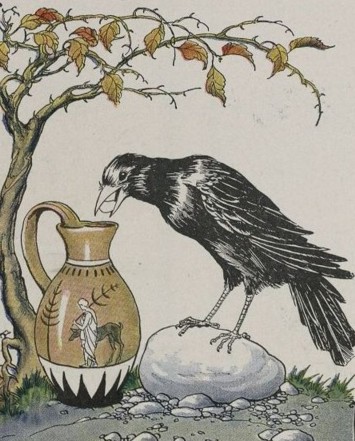We're open daily! View holiday hours
Science News
The Crow and the Pitcher
March 28, 2014
by Molly Michelson

The more experiments scientists perform with crows, the more evidence we see of corvid intelligence. They not only use tools, they make them; and they also use causal reasoning.
To test how much these birds understand about the relationship between cause and effect, researchers took an Aesop Fable, “The Crow and the Pitcher,” to literally see if New Caledonian crows could understand water displacement. According to their study, published this week in PLoS ONE,
In this story a thirsty crow drops stones into a half-full pitcher of water, raising the water level in the pitcher until it is high enough for the crow to drink. In the equivalent experiment subjects are presented with a pile of stones and a tube of water containing a floating reward, such as a worm or meat on a cork.
The subjects were six wild crows that were put through six different experiments. They were successful in four of the water displacement tasks—including preferentially dropping stones into a water-filled tube instead of a sand-filled tube, dropping sinking objects rather than floating objects, using solid objects rather than hollow objects, and dropping objects into a tube with a high water level rather than a low one.
However, the birds failed two of the tasks—one that required understanding of the width of the tube, and one that required understanding of counterintuitive cues for a U-shaped displacement task. According to the authors, the results indicate crows may possess a sophisticated—but incomplete—understanding of the causal properties of volume displacement, rivaling that of five-to-seven year old children.
So there is a ceiling to crow intelligence, perhaps. Lead author Sarah Jelbert explains, “These results are striking as they highlight both the strengths and limits of the crows’ understanding. In particular, the crows all failed a task which violated normal causal rules, but they could pass the other tasks, which suggests they were using some level of causal understanding when they were successful.”
Image: by Milo Winter, from Project Gutenberg